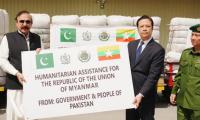ISLAMABAD: Pakistan’s ranking on the Human Development Index (HDI) 2019 fell one notch more and stood at 152nd position out of the total 189 countries. Most alarmingly, Pakistan’s ranking was lower than all comparable regional countries of South Asia.
“Pakistan’s ranking stood at 13 percent below the average HDI of South Asia including Bangladesh and India. Pakistan made progress from 2000 to 2015 but its progress slowed down afterwards” said the Human Development Report (HDR) 2019 launched by the United Nations Development Program (UNDP) here on Thursday. The UNDP’s Policy Analyst Omar Malik presented the key findings of the Human Development Report 2019.
Analyzing the HDI value from 2000 to 2018, the report states that Pakistan’s HDI value was 0.560 in 2018 compared to 0.558 in 2017. Now Pakistan’s ranking stands at 152nd out of the total 189 countries and falls in the medium human development category.
In 2017, Pakistan ranked at 151 position. The HDI improved by 25 percent from 2000 to 2015 with an average annual growth of 1.2 percent but the progress slowed down since then. The improvement could be attributed mainly to education and income indicators.
Despite improvements, Pakistan’s HDI was still lower than comparable economies of South Asian region as it was 13 percent below the average HDI of South Asia and 12 percent below the average HDI of medium human development category. Pakistan was lower on performing on account of life expectancy at birth, expected years of schooling, mean years of schooling and GNI per capita with all the regional countries of South Asia.
On account of Inequality adjusted Human Development Index (IHDI), Pakistan did not perform well as withan IHDI of 0.386 in 2018, Pakistan suffered a loss of 31.1% due to inequality in the distribution of HDI dimension indices.
In comparison, Pakistan had a higher percentage of inequality in the health and education dimension as compared to the average of South Asia and other medium HDI countries. On account of Gender Development Index (GDI), the HDR 2019 states that Pakistan’s ratio of the 2018 female HDI value stood at 0.464 and the male HDI value 0.622, resulted in GDOI value of 0.747.
This signifies low equality in HDI achievements and absolute deviation from gender parity. Pakistan performed below the average values of South Asia and other medium HDI countries.
Dr Sabina Alkire from the Oxford University said that there were 541 million poor people in South Asia in accordance with Multi-Dimensional Poverty Index (MPI) out of which 75 million were in Pakistan and 40 million were alone children.
She said it indicates one out of three children is poor on account of deprivation index of MPI in Pakistan. She highlighted that inequality in MPI across South Asian region as it stood at 0.8 percent in Maldives while 56.9 percent in Afghanistan. She said that 11 percent South Asian girls poor were poor and out of school in accordance with MPI definition but this number stood at 27 percent in case of Pakistani girls. In South Asia, 23% children aged 0 to 4 experience intra household inequality in nutrition but in Pakistan it’s over 33 percent.
She further said that Pakistan’s National MPI ranged from 3 percent in Islamabad and 97 percent in Qila Abdullah of Balochistan province. Dr Ayesha Ghous Pasha, renowned economist and parliamentarian from the PML (N), said all findings of HDR 2019 were quite relevant to Pakistan, as disparities were quire widespread in our country.
She said there were striking facts as Pakistan lagged behind even Bangladesh as our ranking stood at 152nd position while Bangladesh clinched 135th position out of total 189 countries. Pakistan’s left expectancy stood at 67 years while in Bangladesh it was 72 years, she added.
She said the number of 74 million poor people was depressing and they could not be taken care of through targeted schemes so the solution lies for achieving higher and inclusive GDP growth.
Opposition parties strongly criticised move, accusing BJP government of targeting Muslim community ahead of Eid
“Efforts of KP government, led by CM Ali Amin Gnadapur are yielding positive results,” he said in a statement
Despite progress, Khyber-Pakhtunkhwa and Balochistan remain epicentres of violence
As always, Geo Network has curated an exceptional lineup of programming to make Eid even more memorable
£275,000 vehicle was engulfed in flames, prompting bystanders to attempt to extinguish the fire
Bilawal Bhutto Zardari met with flood-affected women and informed them about details of houses







